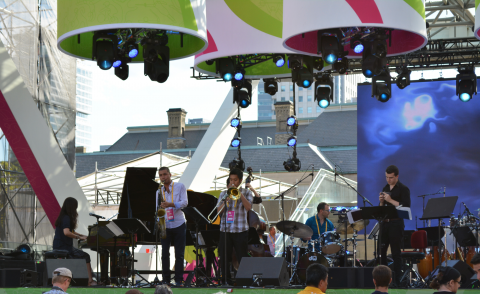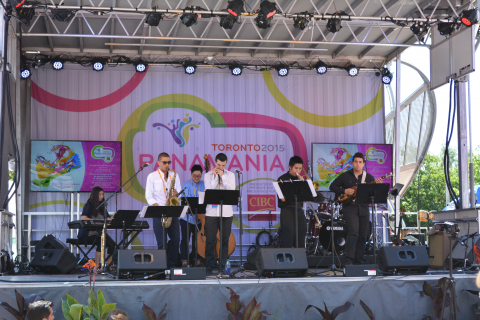Berklee Global Jazz Institute Fosters Mentorship, Artistic Exchange at Pan-Am Games
BGJI students play at Toronto’s Koerner Hall with Mark Kelso at the drums.
Photo by Brian Gonzalez

BGJI students play at Panamania’s Main Stage at Nathan Phillips Square.
Photo by Brian Gonzalez

BGJI students play at Panamania’s Distillery Stage with Mark Kelso.
Photo by Brian Gonzalez
As her bandmates gathered round that evening, GaYoung Bae reflected on the long and intense, but rewarding, afternoon in Toronto.
She and other student musicians in the Berklee Global Jazz Institute (BGJI) had just completed their first of four performances at Panamania, the 35-day arts and culture festival that ran in conjunction with the 2015 Pan-American and Parapan-Am Games this summer.
Their trip kicked off July 21 with an outdoor concert in Nathan Phillips Square, where the Berklee jazz musicians opened for a performance led by Danilo Pérez, a Grammy Award-winning jazz pianist, Berklee professor, and the artistic director of the BGJI. He was joined by longtime bandmates from the Wayne Shorter Quartet: drummer Brian Blade and bassist and Berklee artist in residence John Patitucci.
Students from the BGJI and the renowned jazz trio were scheduled to perform later that week at the studio of Toronto’s jazz radio station, JAZZ.FM91. They all got together that first night to decide, as a group, which pieces they would perform on air.
“Everyone brought one original composition each, and we had to choose two songs that fit in the [time slot],” recalls Bae, a pianist and performance major who earned her undergraduate degree from Berklee in the spring and will begin a master’s degree program with the BGJI in the fall.
“Everyone wants to play their song, right? But everyone was really nice, because they weren’t like, ‘I want to play mine! I want to play mine!’ They didn’t do that,” she adds. “We learned a lot from that experience: When we have to make a decision, we need to be an ‘us’ and not a ‘me.’”
It was one of several moments that became learning opportunities during the three whirlwind days of rehearsals and performances, where Berklee students got the chance to play alongside and learn from professional artists such as Miguel Zenón '98—a Berklee alumnus and saxophonist—and Canadian saxophonist Jane Bunnett.
“It’s one thing to be in school and it’s another thing for our students to work with us in the actual event,” Pérez says. “What we inspire them to do, they see us doing it in the real world. I think that’s the perfect way of closing the circle of mentorship—not only talking about it but also seeing you in real action and doing it in full force.”
Learning from the Pros
In addition to playing in Nathan Phillips Square and at the radio station, BGJI students also participated in concerts in Toronto’s Koerner Hall with the Lula Big Band and another outdoor performance on Panamania’s Distillery stage.
And just as the Pan-Am Games represent a cultural exchange in one sense—bringing together athletes from across North, Central, and South America—the Panamania festival also served as an artistic exchange among upcoming and established musicians.
“When you play music or when you play sports, you become one,” Bae says. “I think music is a kind of tool for society to make us one.”
That notion became especially apparent, Bae adds, when she observed how members of the Lula Big Band interacted with Pérez, Blade, and Patitucci during a rehearsal before their July 22 performance at Koerner Hall.
“They care about each other a lot—like family. It was really amazing [to watch],” Bae says. “We learned a lot every time we were together, from them and from each other.”
She recalls being struck by the humility, dedication, and professionalism the musicians showed toward one another—an experience that would be difficult to capture in the classroom.
“They were very responsible and prepared a lot for the concert with Danilo, Brian, and John, and it really showed in the performance,” Bae says. “We learned a lot from them because even if you are a very good player, you still need to prepare very well. Every time you play, you need to be a pro when you are on stage.”
The first concert in downtown Toronto put that philosophy to the test when an unexpected challenge arose: Travel delays prevented two students from arriving in time to perform, Bae says. At the last minute, a local musician was subbed in—one of Canada’s top drummers and percussionists, Mark Kelso—with only an hour or so to learn the music. Kelso, a native of Ireland, is known as a musical chameleon due to his ability to seamlessly cross genres, according to his alma matter, Humber College’s School of Music in Toronto, where he now heads up the percussion department.
Bae was impressed by how quickly Kelso picked up his part.
“We had just one hour [before we went on stage], and he immediately just got it,” Bae says. “He’s a really, really amazing drummer. Actually, I used to listen to him a lot when I was young, so I was really honored to play with him.”
The opportunity to see how professional musicians meet the demands of a gig as large as Panamania—and adapt on the fly—underscored for the students what it means to play at a higher level of artistry, says Pérez.
“I had to remind them that this was the big leagues, but … they came through. I’m really proud of them,” Pérez says. “When you put together an amazing gathering of talent like this and you collaborate intensely with love and purpose, magic happens.”
‘The Bridge to the Americas’
Following the performances at the radio station later that week, Pérez told the story of the BGJI to listeners and shared its mission: to use music as a vehicle for social change, cultural unity, and creative discovery.
“The Berklee students who performed at our July 23 Panama Connection event were wonderful and embody what we try to do here at JAZZ.FM91—preserve and promote the legacy of jazz and the arts,” says Ross Porter, CEO and president of the Toronto-based station.
As part of the Pan-Am celebrations, Pérez had also been commissioned to compose an original piece for the concert at Koerner Hall with Blade, Patitucci, the Lula Big Band, and some students from the BGJI. Written in three movements, “The Expedition” first tells the story of the arrival of the Europeans. The second movement conveys the region’s connection with Africa. The final movement, “The New World,” captures the contemporary, multicultural fabric of the Americas.
“Since I was a little kid, I always said I wanted to make music that represented the [Panama] Canal—that represented the bridge to the Americas,” says Pérez, a Panama native. “It’s just because of where I was born, because of my roots, because I was listening to music early on without any format. And my desire is for music to really chronicle the history of the Americas.”
